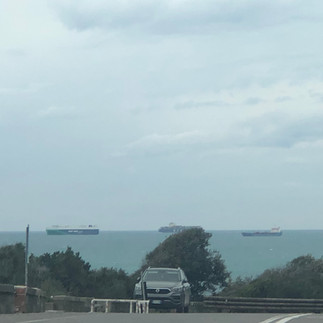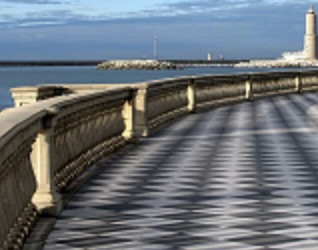Travel: Livorno, Italy, March 8-10/2024
- Lili Naveh
- Mar 10, 2024
- 10 min read
Updated: May 4, 2024
This post is a continuation of a trip North of Rome along the Western coast of Italy.
Civitavecchia -3/6-7 (part 1)
Orbotello 3/8 (part 2)
On the way getting closer to Livorno
Since our drive toward Livorno started from Civitavecchia and continued along the cost passing through Orbotello, Castiglione dela Pescaia and Piombino it took over 3 hours.

Entering Livorno

known in English as Leghorn - this Tuscan seaside West Port City is situated on the Ligurian Sea ,

Much less toured seaside town, Livorno is the third most populous city in the region, right after Florence and Prato. and houses about 160,000 inhabitants.
Livorno is known for its Renaissance-era fortifications, modern harbor with a cruise ship port. and fantastic seafood.
The town's main gathering place. and famous checkerboard paving - central Terrazza Mascagni, could be seen in its full beauty, from the window's hotel we stayed in.
It is situated where once stood a fortress which was part of the coastal defense system. Known as the Cavalleggeri Fort , composed of a tower and a vast building complex.
Built starting in the 1920s, the promenade owes its current appearance essentially to the notable expansion ,carried out after the Second World War and to the important restoration carried out at the end of the last century.


Viale Italia 195 39 0586260836
This 1888 beautiful and historic hotel (along Italy Ave) is set on the waterfront, Grand Hotel Palazzo offers panoramic sea views from its rooms, restaurants rooftop, sun terrace and pool.
The hotel was commissioned by Bernardo Fabbricotti (Italian marvel magnet) who wished to take advantage of the tourism boom, Livorno experienced at the time,.and was designed by Enrico Azzati.
The hotel closed only 10 years after it was opened. During World War II, it was partially destroyed and remained unused. Only in 2004 that the hotel was fully restored and brought back to life.

Among his famous visitors during the brief time that the hotel was open in the 19th c were included King Umberto I, Queen Margherita of Savoy and Guglielmo Marconi.
More recently, the Dalai Lama has stayed at the hotel and Giancarlo Giannini used the space for several film productions.
Views from the Grand Palazzo hotel

Pancaldi Bathing Complex
Bagni Pancaldi, sometimes referred to as Pancaldi Baths or the Pancaldi Acquaviva,
first opened in 1840, and was the only bathing establishment until 1924.
Visitors of Livorno rest, relax, rent sun loungers and/or umbrellas or go for a swim. at the largest swimming pool's of the complex, in the city.
It offers also sports field and boat rentals, and there is also a restaurant on site that serves authentic Tuscan cuisine
Other Landmarks

Fort Vecchia- Medicean Livorno Symbol
Another very visible landmark in the city, is the 16c bastions Fortezza Vecchia facing the harbor, at the Medicean Darsena, or old dock of the port of Livorno, built by the Medici family and open onto Livorno's canal-laced Venezia Nuova quarter.
This old Fortress is a successor building to a medieval fort built by the city of Pisa in the location of an older one, built by Countess Matilda of Tuscany in the 11th c. The 11th century tower was incorporated inside the fort built by the Pisans.

Livorno Light House - Fanale dei Pisani
an active lighthouse located at the south entrance of the Port of Livorno
Built on an emerging rock surrounded by the sea in 1303 by Giovanni Pisano
The tower is covered by grey stone and the lantern dome is painted grey metallic
History in Brief
This originally Etruscan settlement called Labro. never took kindly to being ruled by Pisa and then Florence and somewhere in between being sold to Milan and Genoa in quick succession.
From the 1500s when the Florentine House of Medici, as the new rulers of Livorno, developed and strengthened the small fishing port of Livorno, at the expense of the old Porto Pisano at the mouth of the Arno, Pisa declined as a maritime power (and in fact Porto Pisano then silted up and became unusable)
After the port of Pisa had silted up in , its distance from the sea increased and it lost its dominance in trade, thus Livorno took over as the main and important free port. port in Tuscany (Medici Port)
Since then development flourished, considerably from the second half of the 16th c by the will of the House of Medici, and during the Renaissance, Livorno was designed as an "ideal town". undergoing a period of great urban planning and expansion as of 17c on
Near the defensive pile of the Old Fortress, a new fortress was built, together with the town walls and the system of navigable canals through neighborhoods was created.
The high status of a multiethnic and multicultural Livorno lasted until the second half of the 19th c, when it was surpassed by other cities. Evidence of that prosperous time is seen in the many churches, villas, and palaces of the city.
Livorno suffered extensive damage during World War II. Many historic sites and buildings were destroyed by bombs of the Allies preceding their invasion of Italy, including the cathedral and Synagogue of Livorno.
Since the late 20th century, Livorno's residents have become well known for their left-wing politics. The Italian Communist Party was founded in Livorno in 1921.
Noticeable Monuments, Piazzas, and Structures

Piazza Modigliani
This small square, located right by the Grand hotel we stayed in, and in front of the historic Pancaldi bathing complex
is characterized by the presence of a fountain, one of the very few in the city.
It is a reproduction of Giambologna's Neptune Fountain, (original in Piazza Maggiore in Bologna)
The statue was donated to the city in 1934 by a private citizen The fountain is surmounted by a bronze sculpture of a Neptune and at the base of the basin
There are 4 female figures spraying water from their breasts.

Casa Natale Amadeo Modigliani
Via Roma 38
The house where the known artist Amedeo Modigliani was born,
(1884 – 1920)
The structure is is a typical bourgeois residence of the late 19th
The museum showcases the life of the painter and his works, retraced through family photos, documents and reproductions of works


Villa Mimbelli -Museo civico "Giovanni Fattori"
Via San Jacopo in Acquaviva 65
Before becoming a museum house, the 19th c stunning structure was the residence of one of the most affluent families in the city

The Mimbelli Family was originally from Croatia. The spouses Mimbelli Francesco and Enrichetta Rodocanacchi bought the property about 2 km from the town's centers, and. In 1865 architect Vincenzo Micheli began work on the expansion of the villa and the surrounding park. The villa has three floors and a very elegant facade
The artist Annibale Gatti was called to decorate with stucco ceilings the main rooms of the villa, several with exotic Moorish features.
In 1994 in the villa opened a museum dedicated to the artist Giovanni Fattori.
The collection includes a number of works and biographical items associated with the native Macchiaioli. artist. and to other contemporary works of other Italian Macchiaioli and post-Macchiaioli painters

The large park is open to visitors free of charge and is rich in rare and exotic plants such as some palm trees from the Canary Islands. In the property there is an open air theater built in the 20thc and a private chapel.
Piazza Luigi Orlando

Luigi Orlando (1814 – 1896)
This statue from 1998 of an Italian naval engineer, a politician and director of an historical shipyard is situated at Piazza Luigi Orlando close to the obelisk Obelisco fontana and the sports venue Circolo Arena Astra.
The Yellow building is the front of Cantiere navale fratelli Orlando - historical Italian shipyard of the Orlando Brothers

On the weekend we visited, the entire square was doted all day with tents and stalls selling antiques and trinkets.

Sea Monster Fountains in Piazza Colonnella is a replica from an original
which was commissioned in 1629 for Cosimo I de’ Medici
The 1965 copy fountain, a tribute to the port of Livorno represent triumph of fish, shell-fish, and sea Gods was, a design by 16c sculptor Pietro Tacca - from Carrara who began in a Mannerist style and worked in the Baroque style .
Most famous monument of Livorno- 4 Moors, Piazza Micheli


Monument of the 4 Moors -
commemorate the victories of Ferdinand I of Tuscany over the Ottomans. The bronze black prisoners (convicted Turkish pirates) are at the feet of Ferdinand I

Piazza Micheli.
The 4 Moores monument is a work created by Pietro Tacca in the 17th c. and is situated at the central Piazza Micheli.


The Giuseppe Garibaldi marble statue of the Italian General and national hero, who was part of the battles to unite Italy as a single country. is situated at Piazza Garibaldi
The work, created by the sculptor Augusto Rivalta , was inaugurated in 1889, while the base was designed by Angiolo Badaloni
The area bordering the Fortezza Nuova

The Fortezza Nuova is a fortification designed by Bernardo Buontalenti. dates back to the end of the 16thc at the behest of the Medici government. Currently the New Fortress stands in the middle of a large basin of water and is connected to the city via a small bridge and some mobile piers built in recent years.
It was initially used as a castle and later, after a period of abandonment, an hotel.


The Canal Neighborhood - Venezia Nuava - Little Venice


The establishment of Livorno as a free port with no duties in the late 1580 ignited an International trade, which quickly flourished and the city became an enlightened, tolerant European place, with a diverse immigrant population and one of the most important ports of the entire Mediterranean. This was quickly followed by the construction of a network of navigable canals (the fossi medici) in 1629 and the building of the mentioned above new fortress, fortezza nuova)

The canals remain today long after their initial purpose of transporting goods to and from the port, and form the true ancient center of Livorno and the only part that escaped the worst of the bombing during the war. Much of the architectural heritage remains intact along the canals including many of the buildings previously owned by the wealthy merchant families of Livorno.


Livorno's historic Quartiere Venezia,has undergone some improvements in recent years including a wonderful piece of urban restoration turning Viale Caprera back into a canal more than a century after it was filled in (1898) to make a road.
The canals are quiet during the day but come alive after dark with bars and restaurants bringing life to the whole area .

More of Livorno Scenery

Livorno's Jewish Heritage
The development of the Jewish settlement in Livorno was closely related to the establishment of the free port, and conditioned on laws known as “Livornine”, issued from 1593 onward, and renewed every 25 years. by the Grand Duke of Tuscany who invited to Livorno merchants from any nation – particularly Jews exiled from the Iberian peninsula – offering them rights and protection.
A ghetto was never set up; in fact, the community soon became numerous and influential within the city’s society (1250 people by the mid-17th c), so much so that for almost two centuries, Portuguese was the language used for official deeds.

Synagogue
Testifying to the community’s prestige was the beautiful, historic synagogue. Tempio Maggiore, dates back to 1603. Built in the early 17th c, it repeatedly was enriched and enlarged, and eventually demolished by wartime bombing,
it is remembered as one of the most impressive synagogues in Europe.

The current synagogue designed in 1962 by the Roman architect Angelo di Castro. in a modern style, stands on the site of the majestic 17th c temple, which was demolished following allied bombing in World War II. in `1944
Address: Piazza Elijah Benamozegh, not far from Piazza Grande,
The shape of the building, with its structure in reinforced concrete, is inspired by the Tent of Meeting described in Exodus.
The new Synagogue of Livorno is the main Jewish place of worship of the 700 Jews of Livorno who survived The Holocaust,

Museo Ebraico "Yeshivà Marini"
Via Micali, 20, 57125 Livorno +39 320 8887044 amarantaservizi@gmail.com
The museum irregular hours requires to coordinate a visiting time so one needs to call or email in advance. Since we visited over Saturday and stayed only 2 night, we missed a visit.
The Yeshivà Marini Museum is housed in a neoclassical building already place of worship as Marini Oratory since 1867; once was home of the Confraternity Malbish Arumin which was provided to help the city's poor.
In the post-war period was utilized as a synagogue in the waiting for the construction of the new one. The museum has a collection of liturgical objects coming from the old Synagogue destroyed in World War II. The commerce practiced by the Jews community increased the property of the synagogue allowing a varied religious heritage of Dutch, Florentine, Venetian, Roman and Northern African origin. The display regard the Torah ark, the sefer Torah, paintings, religious objects as the Oriental-style wooden hekhal; the oldest and most important pieces went lost.
Marini Oratory, inside the 18th c suburban villa that belonged to the Livorno merchant family of the same name. In 1867 the building was acquired by the Community which made it the headquarters of welfare brotherhoods; with the racial laws, schools were organized there for pupils and teachers expelled from public institutions; after the war, following the bombings that damaged the large seventeenth-century temple, the Marini Oratory functioned as the only synagogue, until the inauguration of the new temple in 1962.
Jewish Community of Livorno
Piazza Elia Benamozegh, 1
Tel. +39 0586 896290 Email comunitaebraica.livorno@gmail.com
For visits:Cooperativa “Amaranta”Cell. +39 320 8887044E-mail amarantaservizi@gmail.com
Known Cultural Festival
Effetto Venezia, festival now in its 35th year and usually held over two weeks at the end of July into early August. It’s a celebration of summer and one of the most important festivals along the Tuscan coast with a host of events including music, theater, dance, food and wine exhibitions and of course a spectacular fireworks show for the finale.
Upon coming out of a restaurant in the center of town, we met charming local Martha, who works as a Communal Cultural Administer in the city.. She confessed that Livorno has much more local touristic appeal then to the international crowd.
The city mainly markets local cultural affairs and is not willing to market and invest in more. The locals are comfortable with the semi sleeping nature of the township, and are pleased it is not congested nor mobbed by flocks of tourists that congest other neighboring, Tuscan towns like Pisa, Florence or Luca...

Mercato Centrale - Central Market
Officially named 'Mercato delle Vettovaglie', this grand covered market, one of the city's main landmark, was constructed in 1889 -1904 and is an excellent example of the iron and glass architecture that surged all over Europe in the second half of the 19th c
The structure, built along the ‘Fosso Reale’, after the demolition of the defensive structures that had originally been in place since the 16th c, was inspired by Parisian architect of that period.
Recommend Restaurants
Piazza G Michelio 18. 0586891325. ristorante@granduca.it
Viale Caprera 25 0586951455
3756433020
Affordable Local creative cuisine within the Veneziah neighborhood

To be continued....










































































Comments